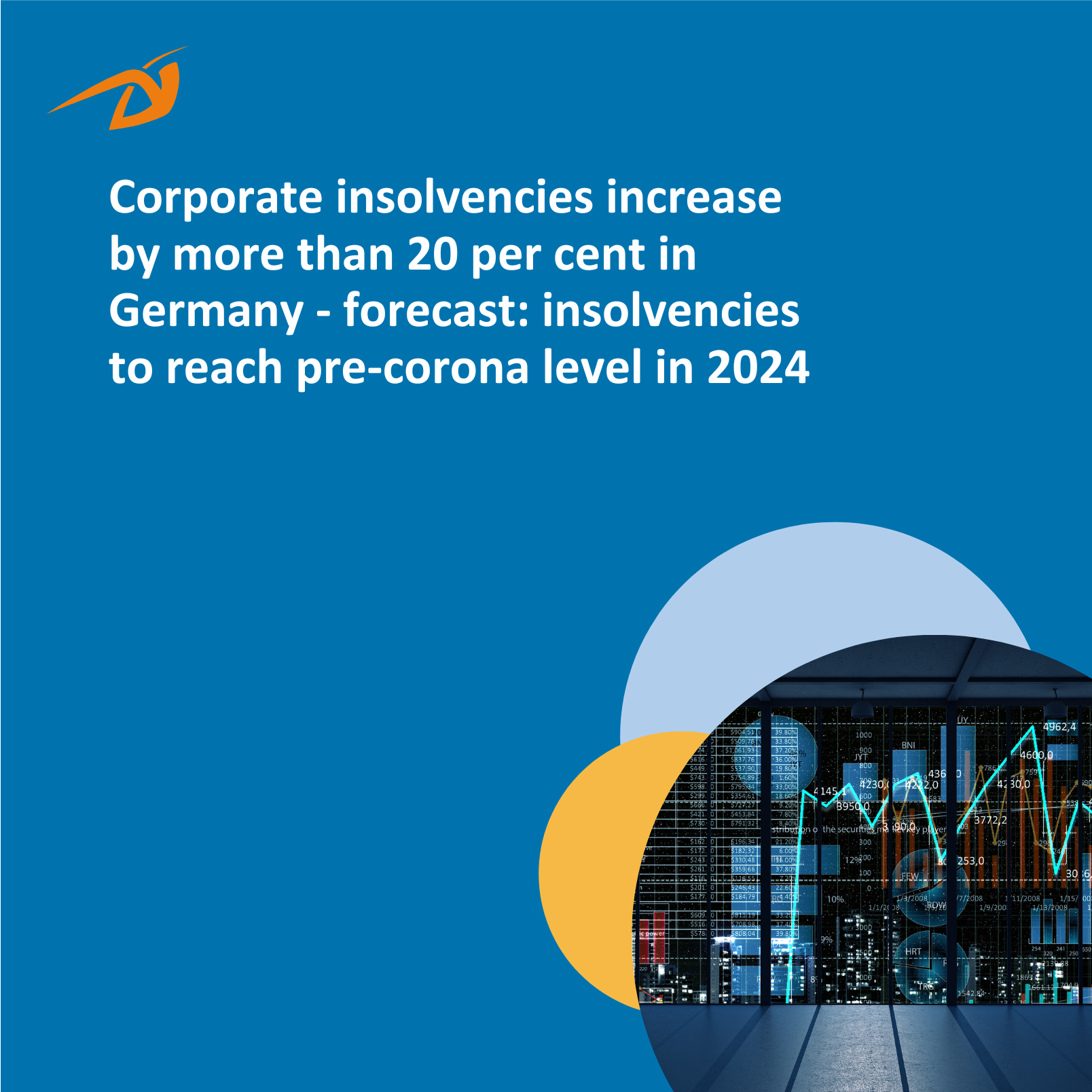-
Corporate insolvencies increase by more than 20 per cent in Germany - forecast: insolvencies to reach pre-corona level in 2024
Read MoreLast year, 17,847 companies filed for insolvency in Germany. This represents a 22.4 per cent increase in company insolvencies...
-
CRIF and Anonos Join Forces to Deliver Responsible AI Solutions Through Privacy-Preserving Synthetic Data in the Age of Generative AI
Read MoreNew York City and Bologna, May 23, 2023 - CRIF and Anonos - an innovator in enterprise data privacy, security and enablement,...
-
Corporate insolvencies rise by 4.2 percent in Germany - moderate increase in corporate bankruptcies forecast for 2023
Read MoreDuring the last year, 14,578 companies filed for insolvency in Germany. This represents an increase of 4.2 percent in corporate...
-
New Supply Chain Act since January: Synesgy platform makes collecting relevant information from suppliers particularly easy
Read MoreSupply chain due diligence act (LkSG) will become a data and IT challenge for many companies - more than 3,600 companies will be...
Decline in personal insolvencies due to base effect - trend reversal in third quarter of 2022 / increase forecast in 2023
Private insolvencies fell in Germany in the first nine months of the year. In total, there were 71,107 private insolvencies in the first three quarters of 2022. This represents a decrease of 13.5 percent compared with the same period last year (Q1-Q3 2021: 82,213). These are the key findings from the current CRIF "Debt Barometer 1st to 3rd Quarter 2022".
The sharp rise in insolvencies last year (plus 93.6 percent year-on-year) has thus now reversed somewhat. The increase in private insolvencies in 2021 was mainly due to the fact that many private individuals withheld corresponding insolvency applications in 2020. The individuals concerned wanted to benefit from the legislative reform to further shorten the residual debt discharge procedure and take advantage of the announced reduction in the duration of the procedure from six to three years and consequently did not file until 2021. The law came into force at the beginning of 2021 and those affected can now be debt-free after just three years instead of six. This is intended to make it easier for debtors to get back on their feet more quickly. This special feature caused private insolvencies to rise particularly sharply in 2021. Consequently, the baseline value (1st to 3rd quarter 2021) is also high and the corresponding percentage change in the nine months of 2022 is distorted at minus 13.5 percent. Despite the high baseline value, there is already a trend reversal in Q3 2022. Looking only at the figures in Q3, personal insolvencies rose by 0.7 percent to 25,047 cases (Q3 2021: 24,884).
The comparison with the first three quarters of 2019 - i.e. before the law reform and before Corona - shows the current high level of insolvencies. According to the report, personal insolvencies increased by 11.8 percent in the first nine months of 2022 (Q1-3 2019: 63,612).
The war in Ukraine and supply chain and inflation problems are having a significant negative impact on the German economy. This also affects private individuals. In particular, the sharp rise in energy prices, but also other commodity and food prices, have led to an inflationary increase in consumer prices. The financial situation of many private individuals in Germany remains strained due to steadily rising rent and energy prices. People in Germany will have less money in their pockets to meet their obligations such as loan payments, rents or financing. In the long run, less income leads first to over-indebtedness and then possibly to private insolvency.
"Rising costs mean that a wave of debt is possible in Germany. If costs rise sharply, it will be difficult for people who have already been living at the subsistence level. Particularly for financially and income-poor households, the financial situation will come to a head - also because financial reserves have been depleted by losses in the Corona pandemic. Economic crises have a delayed impact on consumers. Since insolvency statistics primarily reflect the past, i.e. they are a look in the rear-view mirror, the consequences due to increased costs will have an impact on insolvency figures, especially from 2023 onwards. Even though we are already seeing a trend reversal from the third quarter onwards," comments CRIF Germany Managing Director Dr. Frank Schlein on the current situation. The information service provider CRIF expects 100,000 private insolvencies in Germany in 2022. In 2023, a further increase to up to 120,000 cases is possible.
People who file for personal insolvency do not necessarily have to be heavily in debt. A large proportion of those affected have total debts of just under €10,000. The average debt is currently less than € 19,000.
Private insolvencies by federal state: Most private insolvencies in Bremen, Lower Saxony and Hamburg
Nationwide, there were 85 private insolvencies per 100,000 inhabitants in the first nine months of the year. The northern states are more affected by private insolvencies than the south of Germany. Bremen, for example, leads the statistics with 153 private insolvencies per 100,000 inhabitants. It is followed by Lower Saxony with 120 and Hamburg with 118 insolvencies per 100,000 inhabitants. The states of Schleswig-Holstein (110), Mecklenburg-Western Pomerania (101) and Saxony-Anhalt (100) are also well above the national average. The lowest numbers of private insolvencies were recorded in Bavaria (52 cases per 100,000 inhabitants), Baden-Württemberg (64) and Thuringia (67). In absolute terms, the states of North Rhine-Westphalia (16,577), Lower Saxony (9,637) and Baden-Württemberg (7,141) lead the insolvency statistics.
Percentage changes: Rise in private insolvencies in Hesse and Saxony
Private insolvencies in Germany fell by 13.5 percent nationwide in the first nine months. In Hesse, private insolvencies rose by 4.8 percent year-on-year (Q1-Q3 2021); in Saxony, by 4.5 percent. There were significant declines in the first nine months in North Rhine-Westphalia (down 21.2 percent), Mecklenburg-Western Pomerania (down 20.6 percent) and Bavaria (down 20.5 percent).
The picture changes when the current figures are compared with the first nine months of 2019 - i.e. before the law reform and before Corona. In this comparison, private insolvencies in Hesse increased by 32.3 percent. But Saxony (up 28.7 percent), Bremen (up 26.7 percent) and Bavaria (up 23.1 percent) also saw significantly more private insolvencies in the first three quarters than in the same period of 2019.
Private insolvencies by gender: more men affected by private insolvency
The trend in recent years of men being more likely to be affected by private insolvency than women in Germany is continuing in 2022. 60.9 percent or 43,332 of private insolvencies were reported by men. Men also lead the way in a relative comparison of the sexes. For every 100,000 men, 104 private insolvencies were reported. This compares with 78 private bankruptcies per 100,000 women.





